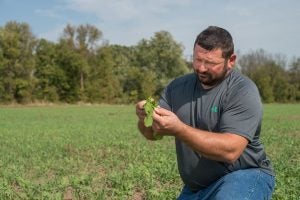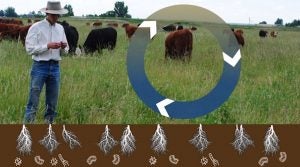As you may have noticed by the previous articles that I have written for AGDAILY, soil health has been a passion of mine for many years. The reason I have been writing and teaching about soil health for so long is because I believe it is the future of agriculture. Not just a future version of agriculture, but how agriculture will literally continue to exist from both an economic and environmental perspective.
The reason I believe this is because a farming enterprise cannot continue to degrade its soil resource while striving to provide a return on investment to the farmer. As a farmer, if you are not currently engaged in purposefully regenerating your soil from the degradation that has occurred in the past, then by default you are continuing to degrade your soil.
Soil regeneration consists of managing your farming activities so that you can measure a return of the functions your soil should perform. These functions include water infiltration and nutrient cycling. If your soil cannot produce a reasonable yield of the crops without the application of fertilizer, and water sits or runs off the field, your soil is not functioning as it should.
Soil functions can be restored in a few short years with management that focuses on the microbial life in the soil. It is the biology in the soil that carries out the majority of the things we expect soil to do, particularly the profitable production of crops. Once the biology of the soil is restored and sustained, the cost of inputs such as fertilizer, pesticides, fuel, and labor can decline significantly. This will contribute to an increased margin of profit to help a farming enterprise grow.

There is currently a unique opportunity that farmers can take advantage of to help take some of the risk out of making changes to their operation in order to improve soil health and future profitability. That opportunity is carbon credits.
Soil that is managed in a way that restores soil health also gathers carbon from the air through living plants and retains that carbon in the soil as soil organic matter. It is currently estimated that farmers could earn roughly $5 to $25 per acre per year if they are practicing farming methods that increase soil organic matter.
Building soil organic matter is a biological process. It can only happen if the soil is managed in a way that fosters the proliferation of biology in the soil. Concurrently, practices such as tillage and excessive nitrogen fertilizer application that result in organic matter being lost to the atmosphere would need to be significantly reduced or eliminated.
» Perspective: Carbon markets can be a good thing for farmers and ranchers
The transition from a biologically deficient, degraded soil to a biologically viable, functioning soil doesn’t happen overnight, but it can happen over a few years. The principles to improve soil health are not complicated. The soil must be disturbed less, planted to a greater diversity of plants, include living roots in the soil as much of the time as possible and keep the soil covered at all times. These principles create the necessary habitat for soil organisms to return to their former stature, sequester carbon from the atmosphere, and make the soil function properly again.
There are farmers practicing these principles on farms in every state in the U.S., so one should be able to seek out a fellow farmer in their area to learn from.

With input costs of fuel, fertilizer and pesticides on the rise, now is an excellent time for farmers to look at making changes in their operation to sequester carbon in their soil while building the capacity of their soil to function and make more efficient use of those costly inputs.
Properly functioning healthy soils provide many ecosystem services that benefit everyone. If farmers can get paid directly for at least the one ecosystem service of carbon sequestration, while improving the ability of their soil to provide a greater return on investment, why not? The future belongs to the farmers who can build their soils while getting the public to recognize the benefits we all accrue from them doing so.
Perhaps by demonstrating that this can be done, farmers will face fewer regulations, create opportunities to get paid for other ecosystem services such as cleaner water or improved wildlife populations. Restoring soil health will also support farms in remaining economically viable to grow crops as well as their business.
Jon Stika is a retired Natural Resources Conservation Service soil health instructor and current part-time professional at the North Dakota State University Dickinson Research Extension Center. He is also the author of “A Soil Owner’s Manual: How to Restore and Maintain Soil Health.”



